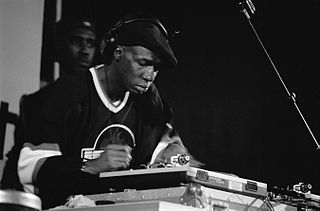
Funk is a music genre that originated in African-American communities in the mid-1960s when musicians created a rhythmic, danceable new form of music through a mixture of various music genres that were popular among African-Americans in the mid-20th century. It deemphasizes melody and chord progressions and focuses on a strong rhythmic groove of a bassline played by an electric bassist and a drum part played by a percussionist, often at slower tempos than other popular music. Funk typically consists of a complex percussive groove with rhythm instruments playing interlocking grooves that create a "hypnotic" and "danceable" feel. It uses the same richly colored extended chords found in bebop jazz, such as minor chords with added sevenths and elevenths, and dominant seventh chords with altered ninths and thirteenths.
Old-school hip hop is the earliest commercially recorded hip hop music and the original style of the genre. It typically refers to the music created around 1979 to 1983, as well as any hip hop that does not adhere to contemporary styles.
The new school of hip hop was a movement in hip hop music, beginning in 1983–84 with the early records of Run–D.M.C., Whodini, and LL Cool J. Predominantly from Queens and Brooklyn, it was characterized by drum machine-led minimalism, often tinged with elements of rock; rapped taunts, boasts, and socio-political commentary; and aggressive, self-assertive delivery. In song and image, its artists projected a tough, cool, street b-boy attitude. These elements contrasted sharply with funk and disco, novelty hits, live bands, synthesizers, and party rhymes of artists prevalent in the early 1980s. Compared to their older hip hop counterparts, new school artists crafted more cohesive LPs and shorter songs more amenable to airplay. By 1986, their releases began to establish hip hop in the mainstream.
Breakbeat is a broad type of electronic music that tends to use drum breaks sampled from early recordings of funk, jazz, and R&B. Breakbeats have been used in styles such as Florida breaks, hip hop, jungle, drum and bass, big beat, breakbeat hardcore, and UK garage styles.
Jazz rap is a fusion of jazz and hip hop music, as well as an alternative hip hop subgenre, that developed in the late 1980s and early 1990s. AllMusic writes that the genre "was an attempt to fuse African-American music of the past with a newly dominant form of the present, paying tribute to and reinvigorating the former while expanding the horizons of the latter." The rhythm was rooted in hip hop over which were placed repetitive phrases of jazz instrumentation: trumpet, double bass, etc. Groups involved in the formation of jazz rap included A Tribe Called Quest, Digable Planets, De La Soul, Gang Starr, The Roots, Jungle Brothers, and Dream Warriors.

Turntablism is the art of manipulating sounds and creating new music, sound effects, mixes and other creative sounds and beats, typically by using two or more turntables and a cross fader-equipped DJ mixer. The mixer is plugged into a PA system and/or broadcasting equipment so that a wider audience can hear the turntablist's music. Turntablists typically manipulate records on a turntable by moving the record with their hand to cue the stylus to exact points on a record, and by touching or moving the platter or record to stop, slow down, speed up or, spin the record backwards, or moving the turntable platter back and forth, all while using a DJ mixer's crossfader control and the mixer's gain and equalization controls to adjust the sound and level of each turntable. Turntablists typically use two or more turntables and headphones to cue up desired start points on different records.

Acid jazz is a music genre that combines elements of funk, soul, and hip hop, as well as jazz and disco. Acid jazz originated in clubs in London during the 1980s with the rare groove movement and spread to the United States, Western Europe, Latin America and Japan. Acts included The Brand New Heavies, Incognito, James Taylor Quartet, Us3, and Jamiroquai from the UK, and Guru, Buckshot LeFonque and Digable Planets from the U.S. The rise of electronic club music in the middle to late 1990s led to a decline in interest, and in the twenty-first century, acid jazz became indistinct as a genre. Many acts that might have been defined as acid jazz are seen as jazz-funk, or nu jazz.

The 2 Live Crew Is What We Are is the debut studio album by hip-hop group the 2 Live Crew. It was released in 1986 on Luke Records to a great deal of controversy and promptly was certified gold by the RIAA. It includes the hits "We Want Some Pussy", "Throw the 'D'", and "Cuttin' It Up". In Florida, it was deemed obscene, and one store clerk was charged with felony "corruption of a minor" for selling it to a 14-year-old girl. The clerk was later acquitted.
Electro is a genre of electronic music and early hip hop directly influenced by the use of the Roland TR-808 drum machines and funk. Records in the genre typically feature heavy electronic sounds, usually without vocals; if vocals are present, they are delivered in a deadpan manner, often through electronic distortion such as vocoding and talkboxing. It palpably deviates from its predecessor boogie by being less vocal-oriented and more focused on electronic beats produced by drum machines.

Northern soul is a music and dance movement that emerged in Northern England and the Midlands in the early 1970s. It developed from the British mod scene, based on a particular style of Black American soul music with a heavy beat and fast tempo.
In popular music, a break is an instrumental or percussion section during a song derived from or related to stop-time – being a "break" from the main parts of the song or piece. A break is usually interpolated between sections of a song, to provide a sense of anticipation, signal the start of a new section, or create variety in the arrangement.

Hip hop or hip-hop is a culture and art movement that was created by African Americans, starting in the Bronx, New York City. Pioneered from Black American street culture, that had been around for years prior to its more mainstream discovery, it later reached other groups such as Latino Americans and Caribbean Americans. Hip-hop culture has historically been shaped and dominated by African American men, though female hip hop artists have contributed to the art form and culture as well. Hip hop culture is characterized by the key elements of rapping, DJing and turntablism, and breakdancing; other elements include graffiti, beatboxing, street entrepreneurship, hip hop language, and hip hop fashion. From hip hop culture emerged a new genre of popular music, hip hop music.

Hip hop production is the creation of hip hop music in a recording studio. While the term encompasses all aspects of hip hop music creation, including recording the rapping of an MC, a turntablist or DJ providing a beat, playing samples and "scratching" using record players and the creation of a rhythmic backing track, using a drum machine or sequencer, it is most commonly used to refer to recording the instrumental, non-lyrical and non-vocal aspects of hip hop.
Deep funk is a subgenre of funk music which features a "hard, lean" sound and emphasis on groove, improvisation, and musicianship over traditional songwriting. The term is also used to describe rare funk recordings sought out by collectors and DJs. Artists such as James Brown and the Meters were basic reference points for the style.

"Renegades of Funk" is a song written by Afrika Bambaataa, Arthur Baker, John Miller & John Robie and recorded by Afrika Bambaataa & Soulsonic Force. Released in 1983 as a single on the Tommy Boy label, it was also included on the 1986 album Planet Rock: The Album. The song is an eclectic fusion of electronic music and heavy percussion, with politically fused hip hop lyrics that draw a connection between past revolutionaries and bohemians to present-day street artists. It was produced and mixed by Arthur Baker and John Robie. Mastering was by Herb Powers Jr..

Frederick Crute, known professionally as Kool DJ Red Alert, is an Antiguan-American disc jockey who rose to fame on WRKS 98.7 Kiss FM in New York City and is recognized as one of the founding fathers of hip hop music and culture. His weekly radio show airs on WBLS 107.5 FM from Monday to Saturday at 6pm EST.

Clive Campbell, better known by his stage name DJ Kool Herc, is a Jamaican American DJ who is credited with being one of the founders of hip hop music in the Bronx, New York City, in 1973. Nicknamed the Father of Hip-Hop, Campbell began playing hard funk records of the sort typified by James Brown.
Hip-hop or hip hop music, also known as rap, and formerly as disco rap, is a genre of popular music that originated in the early 1970s by African Americans and Afro-Caribbean immigrants in the Bronx, a borough of New York City. Hip-hop music originated as an anti-drug and anti-violence genre consisting of stylized rhythmic music that often accompanies rapping, a rhythmic delivery of poetic speech. In the early 1990s, a professor of African American studies at Temple University said, "hip hop is something that blacks can unequivocally claim as their own." By the 21st century, the field of rappers had diversified by both race and gender. The music developed as part of the broader hip hop culture, a subculture defined by four key stylistic elements: MCing/rapping, DJing/scratching with turntables, breakdancing, and graffiti art. While often used to refer solely to rapping and rap music, "hip hop" more properly denotes the practice of the entire subculture. The term hip hop music is sometimes used synonymously with the term rap music, though rapping is not a required component of hip hop music; the genre may also incorporate other elements of the culture, including DJing, turntablism, scratching, beatboxing, and instrumental tracks.

Lance Taylor, also known as Afrika Bambaataa, is an American DJ, rapper, and producer from the South Bronx, New York. He is notable for releasing a series of genre-defining electro tracks in the 1980s that influenced the development of Hip Hop culture. Afrika Bambaataa is one of the originators of breakbeat DJing.
Charles Turner better known as DJ Chuck Chillout, is an American hip hop DJ and producer.











